

(Constance M. White, Film Stars at Riverlea, Hutchison, pp67-8)
Further details of my experiences during the filming
are given in My Experiences as a Disabled Researcher![]() .
.
Outline Shooting Schedule
To a certain extent, the shooting schedule was easy to plan, since it was largely dictated by the centenary events themselves. This gave me the following:
6 April 1994 South Shields Dedication of commemorative plaque at the site of the Misses Stewarts' School, where Brent-Dyer went to school, on the centenary of her birth.
15-17 April 1994 Hereford Friends of the Chalet School residential weekend in the town where Brent-Dyer spent much of her life.
28 May-6 June 1994 Austria Chaletian fan trip to the site of the first fictional school.
11 June 1994 Edinburgh Friends of the Chalet School exhibition at the Museum of Childhood; and fan meeting nearby.
16-19 September 1994 Guernsey Friends of the Chalet School residential weekend on the Channel Island where parts of the Chalet School and Brent-Dyer's La Rochelle series are set.
20 September 1994 Reigate Service of thanksgiving for Elinor M. Brent-Dyer on the twenty-fifth anniversary of her death; and the dedication of a headstone at her grave.
I then needed to look at the detailed plans for the centenary
events taking place, and plan each day of shooting around them.
pro1
South Shields 6 April 1994
Filming was beset with technical problems, since I had
only recently been in a position to purchase the shooting kit and so had
been unable to test it properly beforehand. Both picture and sound quality
were affected: I had been unable to buy a UV filter and the image was affected
by the bright sunlight; and on the way to the station I had been sold the
wrong microphone![]() .
This microphone had only ten inches of cable and was incapable of being
attached to the camera in any way; eventually I had to tie it to the tripod
with rubber bands. Although this proved adequate for the speeches, the
fan whom I had arranged to interview beforehand about why she was there
had a very soft voice. Since I could not get the microphone close enough
to her, she was all but drowned out by the traffic noise in the high pressure
weather. In the end, I cut the scene during editing, since more than one
plaque unveiling by a mayor seemed superfluous (see Hereford 1
.
This microphone had only ten inches of cable and was incapable of being
attached to the camera in any way; eventually I had to tie it to the tripod
with rubber bands. Although this proved adequate for the speeches, the
fan whom I had arranged to interview beforehand about why she was there
had a very soft voice. Since I could not get the microphone close enough
to her, she was all but drowned out by the traffic noise in the high pressure
weather. In the end, I cut the scene during editing, since more than one
plaque unveiling by a mayor seemed superfluous (see Hereford 1![]() ).
I was fortunate that this was possible, and would strongly advise that
other researchers test their kit thoroughly more than forty-eight hours
before filming.
).
I was fortunate that this was possible, and would strongly advise that
other researchers test their kit thoroughly more than forty-eight hours
before filming.
pro2
I also had practical problems because of being disabled:
a detailed description of what took place is given in My Experiences
as a Disabled Researcher![]() .
.
pro3
Hereford 15-17 April 1994
The most crucial event was the Hereford weekend, since more than 150 fans would be attending, but they would be available for less than forty-eight hours and would have to adhere to their own very tight schedule. After looking at the schedule provided by the committee, I sent Goerres and Cridland the following draft schedule for comments.
Friday 15 April 1994
6.45pm: Follow my group of volunteers around the exhibition, filming both the exhibition itself and their comments about it. The feedback I had from the committee was that the exhibition would be too crowded to allow this, so I abandoned the idea. Another reason for not proceeding was that the Edinburgh exhibition would be bigger, and I did not want to use two exhibitions in the film.
7.30pm: Film the illustrated talk. [I will need to shoot the illustrations themselves separately at some point in the weekend, for editing purposes]. In fact I filmed the talk but did not use it, since I used the illustrations separately within the scenes with Helen McClelland.
8.30pm: Film my group of volunteers at dinner [although if you wish to keep this private it's not essential]. The feedback I had was that there was a buffet, so filming was planned, but in the event the overcrowding of the venue made filming impossible.
9.30pm or as dinner ends: Film the first interview with a Castle Pool resident using the dinner as background. Two interviews were recorded, but technical problems - including not switching the microphone on properly - and the high level of background noise when the microphone was working meant that they were not used.
Saturday 16 April 1994
10.45am: Film the unveiling of the plaque from
the vantage point of the volunteers. (Hereford 1![]() ).
).
11.20am: Film second interview if can find appropriate
EBD-related background in the city centre [any suggestions?]. In fact
I remained at Lichfield Lodge, the site of Elinor's former home and the
plaque unveiling, and filmed Ann Mackie-Hunter talking to Kit Gundy (Hereford
2![]() ).
).
12.15pm: Film third interview in coach [this should
be a group of two or three rather than a single person, using the back
seat]. In fact I was given a lift directly to a "Chalet School" site
by Beth and David Varcoe, whom I then filmed (Hereford 3![]() )
This was made problematic by light rain, meaning that I had to film from
under a porch while they stood outside, with the result that the image
was over-exposed.
)
This was made problematic by light rain, meaning that I had to film from
under a porch while they stood outside, with the result that the image
was over-exposed.
2.00pm: Film fourth interview in Hay [I will arrange this with a bookshop in advance so we can use some shelves of children's books as background - any suggestions?]. This interview went ahead in the tea tent provided for FOCS by the Children's Bookshop, but was cut from the final film since it was repetitious.
4.00pm: Film fifth interview on coach [this should
be a group of two or three rather than a single person, using the back
seat]. This plan was abandoned in favour of filming Rachel and Jenny
Davis in my hotel room (Hereford 4![]() ).
).
6.30pm: Film volunteers being photographed at Belmont
Abbey. (Opening sequence![]() .)
The main problem here was that the gym had a sprung floor, making it difficult
to keep the camera steady - although this result was unintentionally effective
in the later booksale footage.
.)
The main problem here was that the gym had a sprung floor, making it difficult
to keep the camera steady - although this result was unintentionally effective
in the later booksale footage.
7.00pm: Film a team which includes volunteers
taking part in quiz. (Hereford 5![]() .)
.)
10pm: Film sixth interview [if I can find a volunteer
who will still be sober!] using dinner as background [I will not film the
dinner itself, as requested]. In fact the dinner did not finish in time
for two planned interviews to go ahead, but I was after all given permission
to film the dinner itself (Hereford 6![]() .)
.)
Sunday 17 April 1994
Am: Film interviews with any volunteers who are
not attending church [any suggestions as to background?]. These interviews
went ahead in a borrowed room at Belmont Abbey, and excerpts were used
in the sound track of the end sequence![]() .
.
12.15pm: Film volunteers attending book sale.
(Elinor 1![]() )
)
Lunch: Film speeches. The sound on these did not record because of damage to the microphone.
2.15pm: Film volunteers attending afternoon activities [can you let me have the details?] In fact I abandoned this idea in favour of more interviews, although some were unusable because of microphone damage.
4.15pm: Film final interview(s) with volunteers
who are able to stay a little later [venue to be decided - any suggestions?].
These
interviews went ahead in a borrowed room at Belmont Abbey, and excerpts
were used in the sound track of the end sequence![]() .
.
pro4
Throughout the weekend, my major problem was in coping with the size of the crowd attending. Physically, I was frightened of being knocked into, and I was also frightened for the camera. My film diary records:
(16 April) [plaque unveiling] stampede with cameras at end prevented good shots and also stopped replay for close-up which had been arranged. Lesson - don't work with 160 people! . . . [The Children's Bookshop] constant problem with numbers - one effect meant lack of mobility for camera - had to find safe position and stay there . . . [dinner] Constantly getting up to protect mike, particularly from waiters . . . Moved tripod to small centre table to film cake - similar problems as with plaque in terms of hordes with cameras.
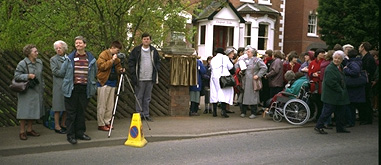
Photo: Jean Bradford
A few days after the weekend, I filmed Ann Mackie-Hunter
and Gill Bilski (FOCS 2![]() )
in the room where Gill runs her book-dealing business in Buckinghamshire.
Following this, I had three weeks' break from filming; this was essential
to regain my strength.
)
in the room where Gill runs her book-dealing business in Buckinghamshire.
Following this, I had three weeks' break from filming; this was essential
to regain my strength.
pro6
Austria 28 May-6 June 1994
The major problem which I had in Austria, as detailed
in My Experiences as a Disabled Researcher![]() ,
was physical. Other than that, filming was severely limited by poor weather
conditions, and the lack of a fixed schedule meant that planning was difficult.
In the event, filming the group was concentrated over two days.
,
was physical. Other than that, filming was severely limited by poor weather
conditions, and the lack of a fixed schedule meant that planning was difficult.
In the event, filming the group was concentrated over two days.
pro7
31 May 1994: I filmed the boat trip (Austria
1![]() );
steam train trip (Austria 2
);
steam train trip (Austria 2![]() &3
&3![]() );
and the walk at Mayrhofen (Austria 4
);
and the walk at Mayrhofen (Austria 4![]() ).
).
pro8
1 June 1994: I filmed the cable car trip (Austria
5![]() );
and walk on the Bärenbad alm (Austria 6
);
and walk on the Bärenbad alm (Austria 6![]() ).
).
pro9
Arranging the interviews was more difficult. My film diary records:
[3 June 1994] . . . Daphne grabbed me at 8.30am and suggested doing interview - bit of shock but had gear all ready from night before. Also arranged to do S. that afternoon if still fine. Little sun but clear, found spot at beginning of Gaisalm path. Found afterwards that came out well, but had to use auto mode because of rush (D had to get bus at 9.45am). Difficult to say if focus shifting in viewfinder - D sways back and forth - although exposure seemed okay. (Had used autofocus for Anne although had altered exposure - luckily she was very static.) Had warned D might need to repeat, but usable - will just use v. little of face [in the event I just used the sound track]. Sound very good . . .
[4 June 1994] . . . At 3.30pm met in hall to go and see chalet that was site of school, and memorial plaque erected as a result of Martin Spence's sponsored swim across the Achensee, in order for me to video them. As Julie Ann opened the door the rain started! Particularly sorry as the others had dressed ready in their Chalet sweatshirts.
[5 June 1994] Last day. Woke planning to interview R and S at 8.30am, but sure enough the rain started then. Had snowed on alps in night . . . D then decided to start the planned walk immediately . . . interviewed R and S finally - on balconies!
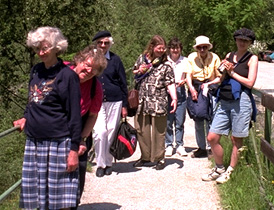
Photo: Gillian Priestman
Edinburgh 11 June 1994
The Edinburgh shoot was easy to plan, since it was concentrated
in one day. The major difficulty for me was that it took place within a
week of my return from Pertisau, when I was physically exhausted. I was
extremely fortunate in that my partner drove me to Scotland the day before
and transported the equipment around Edinburgh during filming, and also
that I had friends who provided us with accommodation, since without this
help it would have been logistically impossible.
pro11
As it was, I began filming on Saturday morning at the
exhibition (Edinburgh 1![]() ),
following a phone call from the Centenary Committee introducing me to the
museum staff. The museum staff were extremely helpful; even, to my embarrassment,
offering to close the exhibition to allow me to film undisturbed. As I
had sufficient time, I was able to film all of the exhibits in detail,
and to adjust the exposure and focus manually in order to get the best
possible image quality. I was then able to break before returning to the
museum to meet a group of fans, who willing allowed themselves to be filmed
entering the museum building and looking around the exhibition (Edinburgh
2
),
following a phone call from the Centenary Committee introducing me to the
museum staff. The museum staff were extremely helpful; even, to my embarrassment,
offering to close the exhibition to allow me to film undisturbed. As I
had sufficient time, I was able to film all of the exhibits in detail,
and to adjust the exposure and focus manually in order to get the best
possible image quality. I was then able to break before returning to the
museum to meet a group of fans, who willing allowed themselves to be filmed
entering the museum building and looking around the exhibition (Edinburgh
2![]() ).
).
pro12
The main problem arose when the time came to carry out
the first two interviews, with Lilian Smith (Edinburgh 2![]() )
and Shirley Skinner (this was dropped from the final editing script). The
museum was extremely noisy, with traffic noise from the Royal Mile outside
and music from a xylophone adding to the sound of children's voices inside.
In the end, the only place we could find to film the interviews was a stairwell,
with the added complication of people occasionally wanting to climb up
the stairs. (In retrospect, I should have contacted the museum staff with
more definite plans earlier in the week, but the exhibition had only opened
while I was in Austria and I had been exhausted in the few days since I
had returned.)
)
and Shirley Skinner (this was dropped from the final editing script). The
museum was extremely noisy, with traffic noise from the Royal Mile outside
and music from a xylophone adding to the sound of children's voices inside.
In the end, the only place we could find to film the interviews was a stairwell,
with the added complication of people occasionally wanting to climb up
the stairs. (In retrospect, I should have contacted the museum staff with
more definite plans earlier in the week, but the exhibition had only opened
while I was in Austria and I had been exhausted in the few days since I
had returned.)
pro13
I then compounded these problems by not asking the other
interviewee or my partner to hold the microphone steady, since Lilian in
particular was extremely nervous and fidgeted with the microphone. In fact,
Lilian's interview is one of the most charming in the film, but the soundtrack
required a great deal of work to reduce the microphone-handling noise to
an acceptable level. Following the interviews I crossed the road to a nearby
arts centre cafe, where Scottish fans were meeting (Edinburgh 3![]() ).
Filming here was also problematic, due to bright sunshine and loud traffic
noise - throughout the Edinburgh filming, the need for an additional, directional
microphone with a shorter range
).
Filming here was also problematic, due to bright sunshine and loud traffic
noise - throughout the Edinburgh filming, the need for an additional, directional
microphone with a shorter range![]() was exposed.
was exposed.
pro14
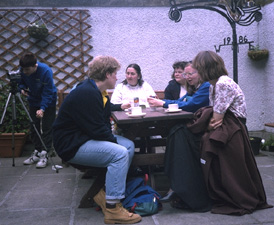
Photo: Lilian Smith
Guernsey 16-19 September 1994
As with Hereford, the shooting schedule was largely dictated
by the schedule organised for the fans. The major problem for me was that
the women who had previously helped me with my equipment were not taking
part in the trip, and I had also found the flight very fatiguing. In addition,
poor weather made filming problematic, and the soundtrack of Guernsey
1![]() reflects the windy conditions. In the end, I did not use most of the footage,
limiting the scenes to the fact of the visit and the background of Mo Everett,
the local woman who coordinated it. However, this was not solely as a result
of the problems which I had faced, since I had some good footage which
I simply felt was not relevant to the overall story of the film
reflects the windy conditions. In the end, I did not use most of the footage,
limiting the scenes to the fact of the visit and the background of Mo Everett,
the local woman who coordinated it. However, this was not solely as a result
of the problems which I had faced, since I had some good footage which
I simply felt was not relevant to the overall story of the film![]() .
.
pro15
Friday 16 September 1994
7pm: Social gathering. This was not filmed.
Saturday 17 September 1994
9am: Walk round St Peter Port, led by Mo Everett.
(Guernsey 2![]() )
)
10.30am: Drive to Jerbourg; stop for coffee and
gache. (Guernsey 2![]() )
)
11.30am: Walk to Petit Port; drive to Blanchelands; drive to Pleinmont. This was filmed, but not used.
Lunch: Rocquaine. (Guernsey 1![]() )
)
PM: Pleinmont; Lihou. This was filmed, but not used.
7pm: Dinner and quiz at Mo Everett's. This was filmed, but not used.
Sunday 18 September 1994
10am: Church services. I used this time to film panoramic shots of St Peter Port, although I did not use these in the final film.
12 noon: Moulin Huet, followed by lunch. This was filmed, but not used.
PM: Saints Bay; Vale; Oaklands Craft Centre. This was not filmed, due to poor weather conditions.
7.30pm: Dinner at Idlerocks hotel. This was not filmed.
Monday 19 September 1994
10am: Interviews with Mo Everett(Guernsey 2![]() ),
and Polly Goerres and Clarissa Cridland (FOCS 3
),
and Polly Goerres and Clarissa Cridland (FOCS 3![]() ;
Edinburgh
1
;
Edinburgh
1![]() ;
Guernsey
1
;
Guernsey
1![]() ;
Final
Years 2
;
Final
Years 2![]() &
3
&
3![]() )
)
pro16
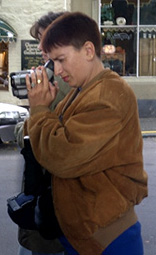
Photo: Joy Wotton
Reigate 20 September 1994
The major problem which I faced with the Reigate shoot
was the fact that it took place the day after my return from Guernsey,
when I was physically exhausted. It could also have been problematic in
that my equipment had been used extensively over the weekend, and faults
could easily have developed. I was fortunate in that I was able to clean
the camera and recharge the batteries on Monday night; that the camera
functioned faultlessly; and that I again had the assistance of my partner,
who drove me first to the church and then to the cemetery and who carried
my equipment for me. Nonetheless, I did make one basic error in that I
missed the opportunity I had to place the microphone closer to the pulpit,
which meant that the sound quality on Final Years 2![]() is problematic and required a great deal of work during post-production
is problematic and required a great deal of work during post-production![]() .
.
pro17
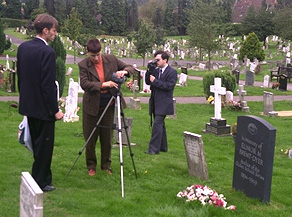
Photo: Joy Wotton
Interviewing Key Characters
Essentially, the film tells two stories: the story of
Elinor M. Brent-Dyer and her Chalet School series (the two cannot be separated);
and the story of the centenary celebrations held by her fans. Elinor M.
Brent-Dyer's story would be told by her biographer, Helen McClelland. A
week after the Hereford weekend, on 21 April 1994, I wrote to her to arrange
a date for the filming, offering dates in May and June (archived correspondence).
In the event, we met on 23 July to discuss her script, and then allowed
three weeks for liaising on changes before filming on 17 August. This was
jeopardised on the morning of the filming by a faulty circuit in the camera;
I had failed to test it properly after "repairs". Fortunately, the Sony
service centre was able to carry out an immediate further repair, so filming
went ahead as scheduled. I would however warn other researchers of the
necessity to check that any repairs made to their equipment have in fact
been carried out successfully.
pro18
I filmed McClelland in her home, sitting in a chair in
her sitting room. (This was a shot which I "borrowed" from films presented
in the BBC2 Bookmark series.) Unlike the other key characters, I
did not include any Chalet School books in the shot. Instead, the only
book which was visible was McClelland's biography, Behind the Chalet
School; this stressed that McClelland was telling the story of Brent-Dyer.
I took a deliberate decision to film McClelland speaking directly to the
camera. This is a shot which conventionally is only granted to newsreaders
and the Royal family, since it symbolises total authority. Here, however,
I wanted to stress McClelland's authority, and also to create the illusion
that she was addressing the viewer directly.
pro19
One difficulty which I did have was with sound. McClelland's
home lay under a Heathrow flightpath, and the loud ticking of a clock competed
with a drip from an overflowing drain. This was one occasion where a mono,
uni-directional tie-clip microphone with a shorter range would have been
extremely useful. As I did not have access to this, I decided to make the
best of it, feeling that the ticking would subliminally underline the chronological
structure of the final film, and that any aircraft engine noise would underline
the fact that each scene with McClelland was followed by a new geoographical
location for the Chalet fans.
pro20
By the time that I filmed McClelland I had already arranged
to interview the Centenary Committee, Polly Goerres and Clarissa Cridland.
This had proved hard to arrange, since one lived in the Midlands and the
other near Bath, and both needed to be in the same place for the filming
to go ahead - and in a place which I could get to as well. Unfortunately,
shortly before the scheduled interview, in July 1994, I discovered that
the camera was not working, and the filming had to be postponed while repairs
were carried out. One lesson which I learned from the problems which I
experienced in filming both these key interviews is that equipment failure
is always a problem when carrying out any technical exercise, but with
domestic equipment - or much-used equipment from the academy - time must
be built into the schedule to allow for this; a strong nerve also helps.
pro21
During this time I completed the first draft of the editing
script![]() ,
and on 25 July I sent a copy to Polly and Clarissa, explaining the information
which I needed them to give at each point in the film
,
and on 25 July I sent a copy to Polly and Clarissa, explaining the information
which I needed them to give at each point in the film![]() .
This helped a great deal when filming did go ahead, as both interviewees
were extremely tired at the time. The only time which proved possible to
film them was the Monday morning of the Guernsey weekend, when I also filmed
my interview with Mo Everett (Guernsey 2
.
This helped a great deal when filming did go ahead, as both interviewees
were extremely tired at the time. The only time which proved possible to
film them was the Monday morning of the Guernsey weekend, when I also filmed
my interview with Mo Everett (Guernsey 2![]() ).
In both cases I set the camera up so that I was directly facing the interviewees,
who then talked into the camera as if they were recording a "video diary".
I felt that this was better than attempting to duplicate professional television
interviews, given that the quality of the footage would then only highlight
the differences in production budgets. My shots would make it quite clear
that domestic video was being used, but at the same time would possess
an intimacy and control by the subject that a professional production would
lack.
).
In both cases I set the camera up so that I was directly facing the interviewees,
who then talked into the camera as if they were recording a "video diary".
I felt that this was better than attempting to duplicate professional television
interviews, given that the quality of the footage would then only highlight
the differences in production budgets. My shots would make it quite clear
that domestic video was being used, but at the same time would possess
an intimacy and control by the subject that a professional production would
lack.
pro22
Other key characters included Sue Sims, collector, researcher
and editor of Folly magazine. Sims preferred the weekday daytime
for filming, since she was and is the mother of young children. (A great
deal of my research and filming took place during the evenings and at weekends,
since book-collecting is a leisure activity, and I was fortunate that this
was not a barrier to my carrying out the research.) This interview went
as planned (Hereford 5![]() ),
with the only hitch being that Sims, after a night spent up with a sick
child, had fallen asleep in the bath and so didn't realise that I had arrived
for twenty minutes. My partner, who drove me to Bournemouth for the interview,
had ceased to believe that the door would ever open, but throughout my
interviewees proved to be extremely reliable and my nerve held. I filmed
Sims in a similar manner to Goerres et al, but in the event only used the
soundtrack.
),
with the only hitch being that Sims, after a night spent up with a sick
child, had fallen asleep in the bath and so didn't realise that I had arrived
for twenty minutes. My partner, who drove me to Bournemouth for the interview,
had ceased to believe that the door would ever open, but throughout my
interviewees proved to be extremely reliable and my nerve held. I filmed
Sims in a similar manner to Goerres et al, but in the event only used the
soundtrack.
pro23
One unexpected problem which I only realised fully after
I had reached the end of my shooting schedule was that I had only obtained
one interview with a child who read the Chalet School series, and this
was about mother-daughter enjoyment of the series (Hereford 4![]() )
rather than girls reading the books today. The lack of girls on film was
entirely due to the fact that the centenary activities had been deliberately
targeted at adult women collectors. However, since the research and film
were about children's - or girls' - books, viewers would have an expectation
that girls would feature in the film, and this expectation would have to
be met. I therefore contacted the Centenary Committee and asked if any
activities were planned for junior members. I received the reply that none
had been, but that I had the Committee's full permission to organise a
day's activities for their junior members for the purpose of filming.
)
rather than girls reading the books today. The lack of girls on film was
entirely due to the fact that the centenary activities had been deliberately
targeted at adult women collectors. However, since the research and film
were about children's - or girls' - books, viewers would have an expectation
that girls would feature in the film, and this expectation would have to
be met. I therefore contacted the Centenary Committee and asked if any
activities were planned for junior members. I received the reply that none
had been, but that I had the Committee's full permission to organise a
day's activities for their junior members for the purpose of filming.
pro24
I decided that the most appropriate date would be during
the half-term holiday, avoiding weekends since family activities tend to
take place then, and I opted for Monday 24 October 1994. I next needed
to find a safe place to hold the day, bearing in mind that it also needed
to be easily accessible and therefore central. The obvious venue was The
Wheel, also known as the London Women's Centre, which was close to Covent
Garden, Holborn and Charing Cross stations, had full disabled access, good
security, and met fire and safety regulations. Most of the rooms were already
booked, but I felt that the theatre, which was free, was an ideal location
and hired this. I also decided that I should not run the day alone - for
instance, if a girl had had an accident there would have been no one to
look after the rest - and enlisted the help of Anne Thompson, a retired
teacher who had appeared in the scene Austria 3![]() .
.
pro25
The Centenary Committee had sent me a copy of their mailing
list, so at the beginning of October I wrote to all of the girls whom I
believed were in commuting distance of London, enclosing parental permission
slips. Six girls responded positively, who all attended on the day (they
became the core of the resulting London and South East Junior Chalet School
Collectors' Group![]() ).
I then faced two problems. The first was that the girls were extremely
shy; the second was that there was a generator mounted on the wall underneath
the theatre, providing a constant background hum. I therefore decided not
to use the camera until the afternoon, and concentrated during the morning
and lunchtime on putting the girls at their ease, getting to know them
and helping them to get to know each other. This strategy was successful,
but meant that I had no opportunity to obtain footage of them behaving
"naturally".
).
I then faced two problems. The first was that the girls were extremely
shy; the second was that there was a generator mounted on the wall underneath
the theatre, providing a constant background hum. I therefore decided not
to use the camera until the afternoon, and concentrated during the morning
and lunchtime on putting the girls at their ease, getting to know them
and helping them to get to know each other. This strategy was successful,
but meant that I had no opportunity to obtain footage of them behaving
"naturally".
pro26
I then asked the girls to suggest how they should be filmed,
and this was a useful strategy in that they became much more enthusiastic
about the filming as a result. They decided to sit around a table, and
created a background using screens from the back of the theatre. All of
them had brought some of their Chalet books with them, and they arranged
these on the table in front of them. It was clear that they were going
to be too self-conscious to have a spontaneous "conversation", and in any
case I would have serious problems in framing the shots if they did. (This
type of scene would normally have been shot with two cameras, and in addition,
the camera had only an 8x zoom which made wide angle photography difficult.)
As a result, I arranged to ask questions of each of them in turn, or for
them to put their hand up if they wanted to say something, and this was
then edited successfully to appear as a conversation (FOCS 1![]() ).
).
pro27
Unsurprisingly, the main problem with this scene was sound.
One reason was the generator noise, which inevitably affected the sound
track. This was compounded by the fact that the girls were shy and spoke
softly; as a result, the microphone "gained up", thus magnifying the generator
noise. Another reason for the poor sound quality was the fact that I was
attempting to record the sound from six girls on one microphone, without
even an assistant to move the microphone around as the girls spoke. Following
a great deal of work in the dubbing studio, the sound is audible, but is
noticeably the poorest-quality scene in the film in this respect. Recording
the sound separately might have been one successful strategy, but in any
case I should certainly have not taken it for granted that a performance
space would be suitable for recording purposes.
pro28
Shooting Stills
I did not schedule the stills into the filming, since
I was unsure about how best to do this and was not in receipt of all of
the illustrations until editing had begun. I was then advised by VeT, the
company who provided the Avid training and facilities![]() ,
that the best format to use would be Beta SP
,
that the best format to use would be Beta SP![]() ,
and I was loaned one of their cameras. In general this worked very well,
and the quality of the stills was high. However, there were two problems,
caused by the fact that I had never used a Beta SP camera before and was
completely unfamiliar with the camera on loan to me, and compounded by
the fact that I had to film the stills at the weekend, when no technical
support existed.
,
and I was loaned one of their cameras. In general this worked very well,
and the quality of the stills was high. However, there were two problems,
caused by the fact that I had never used a Beta SP camera before and was
completely unfamiliar with the camera on loan to me, and compounded by
the fact that I had to film the stills at the weekend, when no technical
support existed.
pro29
I therefore made the following errors. First, I was unaware
that a "Macro" button existed for close-ups, and so was unable to obtain
a sharp focus when filming text on the front covers of the fanzines. Second,
I was unaware that the camera's viewfinder and the monitor attached to
it showed an image area greater than that which can be seen on video. Unknown
to me, this had been a problem throughout filming, since, while the majority
of cameras have their viewfinders marked with the outline of the smaller,
viewing area, neither my Hi8 nor the Beta SP camera did. This lack of knowledge
is most noticeable when screening stills, since it was extremely difficult
to frame them successfully in the first place. As a result, some of the
stills appear to be over-cropped.
pro30
| Dr Ju Gosling aka ju90's ABNORMAL: How Britain became body dysphoric and the key to a cure is available now for just £3.09 for the Kindle or in a limited-edition hardback with full-colour art plates for £20 inc UK postage and packing. | 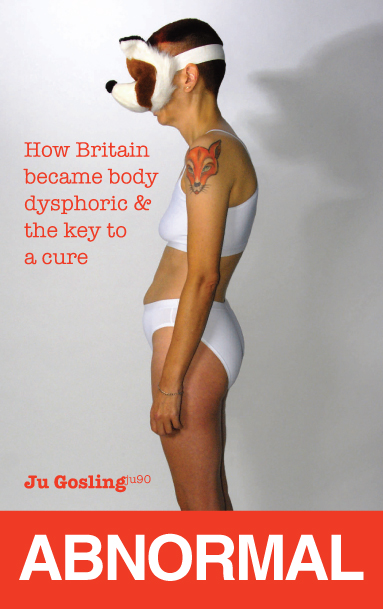 |